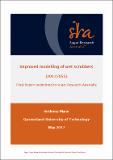| Author | Mann, AP |
| Author | Plaza, F |
| Author | Hobson, P |
| Date Accessioned | 2017-06-22 |
| Date Available | 2017-06-22 |
| Issued | 2017 |
| Identifier | http://hdl.handle.net/11079/16424 |
| Abstract | While wet scrubbers have high collection efficiency, operational problems associated
with many wet scrubber installations reduce boiler steam output and, therefore, factory
crushing rates. These problems include: |
| Abstract | Blockages that increase the pressure drop across the scrubbers. This reduces the
gas flow through the boiler and, therefore, boiler steam output. |
| Abstract | Droplet carryover that causes build-up on and wear of boiler induced draft fans,
reduces collection efficiency and generates complaints from the local community. |
| Abstract | The need to improve the design of centrifugal wet scrubbers provided the motivation for
this work which uses computational fluid dynamics (CFD) modelling and scale model
experiments. The modelling and experiments were used to develop an improved
understanding of the flow processes occurring in a centrifugal wet scrubber and to
evaluate options for improving their performance. This project falls within the SRA key
focus area of milling efficiency and technology. |
| Abstract | Recent record high levels of electricity export from sugar factories have corresponded to
record low levels of dust emissions from sugar factory boilers. One of the main reasons
for low emissions is the increased use of wet scrubbers for removing dust from boiler
flue gas. |
| Language | en |
| Publisher | Sugar Research Australia Limited |
| Part of Series | ;2012/055 (QUT055) |
| Subject | Milling |
| Subject | Technology |
| Subject | Emissions |
| Title | Improved modelling of wet scrubbers : final report 2012/055 |
| Keywords | Wet scrubbers, Emissions, flue gas and droplet flows, agglomeration, bulk water, dust particles, modelling capability, scrubber designs. design modification, milling improvement, adoption of technology |

